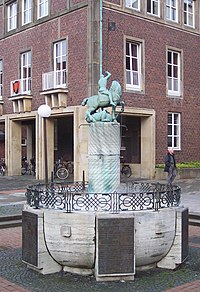Ahaus
Ahaus | |
|---|---|
 St George's Fountain in Ahaus | |
Location of Ahaus within Borken district  | |
| Coordinates: 52°4′N 7°0′E / 52.067°N 7.000°E | |
| Country | Germany |
| State | North Rhine-Westphalia |
| Admin. region | Münster |
| District | Borken |
| Subdivisions | 6 |
| Government | |
| • Mayor (2020–25) | Karola Voß[1] (Ind.) |
| Area | |
| • Total | 151.22 km2 (58.39 sq mi) |
| Highest elevation | 70 m (230 ft) |
| Lowest elevation | 36 m (118 ft) |
| Population (2022-12-31)[2] | |
| • Total | 40,245 |
| • Density | 270/km2 (690/sq mi) |
| Time zone | UTC+01:00 (CET) |
| • Summer (DST) | UTC+02:00 (CEST) |
| Postal codes | 48683 |
| Dialling codes | 02561, 02567 |
| Vehicle registration | BOR, AH, BOH |
| Website | www.ahaus.de |
Ahaus (German pronunciation: [ˈaːhaʊs] ⓘ; Westphalian: Ausen) is a town in the district of Borken in the state of North Rhine-Westphalia, Germany. It is located near the border with the Netherlands, lying some 20 km south-east of Enschede and 15 km south from Gronau. Ahaus is the location of one of Germany's interim storage facilities for radioactive spent fuel.[3]
History
The first written mention of the aristocratic seat of Haus an der Aa dates from around 1030. Around 1120, Bernhard von Diepenheim had Ahaus Castle built where Ahaus Castle stands today. In 1154 his son Lifhard called himself von Ahaus for the first time.[4] The lords of Ahaus belonged to the smaller noble dynasties in Westphalia in the wider environment of the Munster bishops. They got into a fight with them in 1176 when the nobleman Johann von Ahaus gave his castle as a fief to the Archbishop of Cologne. In 1177, however, John had to surrender to Prince Bishop Hermann II of Munstersubdue. The castles of Ahaus and Diepenheim, which belonged to the noble lords of Ahaus, were destroyed. Nevertheless, the noble lords remained in possession of their rule.[5]
In 1389 the noble lords of Ahaus granted the castle settlement an excise privilege. Two years later, Ahaus received city rights. In 1406, the Prince-Bishop of Munster, Otto IV von Hoya, bought the lordship of Ahaus and incorporated it into the Bishopric of Munster.[4] It was combined by the Bishopric of Münster together with 24 parishes, which extended over large parts of West Münsterland, to form the Amt of Ahaus . It lasted until it was dissolved by the Reichsdeputationshauptschluss in 1803.
Twin towns – sister cities
 Argentré-du-Plessis, France
Argentré-du-Plessis, France Haaksbergen, Netherlands
Haaksbergen, Netherlands
Notable people
- Friedrich Koechling (1893–1970), officer, general of infantry
- Michael Denhoff (born 1955), composer and cellist
- Jens Spahn (born 1980), politician (CDU), Member of Bundestag
- Heike Wermer (born 1988), CDU politician
- Urszula Radwańska (born 1990), Polish tennis player
- Stefan Thesker (born 1991), footballer
See also
References
- ^ Wahlergebnisse in NRW Kommunalwahlen 2020, Land Nordrhein-Westfalen, accessed 19 June 2021.
- ^ "Bevölkerung der Gemeinden Nordrhein-Westfalens am 31. Dezember 2022 – Fortschreibung des Bevölkerungsstandes auf Basis des Zensus vom 9. Mai 2011" (in German). Landesbetrieb Information und Technik NRW. Retrieved 20 June 2023.
- ^ Interim Storage of Spent Fuel in Germany History, State and Prospects, Bundesamt für Strahlenschutz, June 2015.
- ^ a b "www.ahaus.de: Geschichte". 2016-01-19. Archived from the original on 2016-01-19. Retrieved 2023-07-12.
{cite web}: CS1 maint: bot: original URL status unknown (link) - ^ "Internet-Portal 'Westfälische Geschichte'". www.lwl.org (in German). 2014-03-25. Retrieved 2023-07-12.
- ^ "Städtepartnerschaften". stadt-ahaus.de (in German). Ahaus. Archived from the original on 2021-11-25. Retrieved 2021-02-04.



